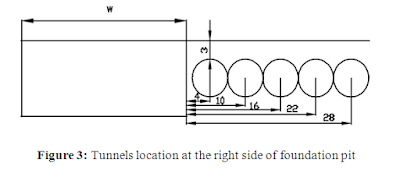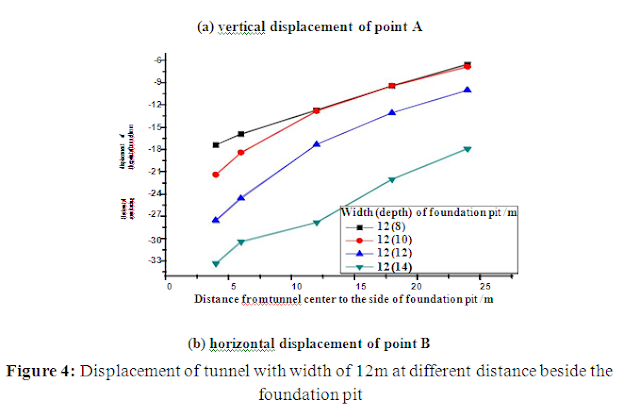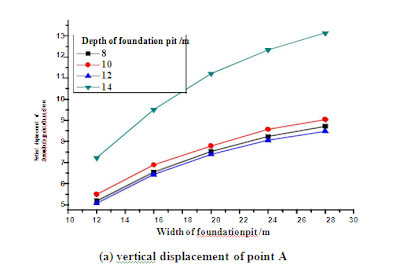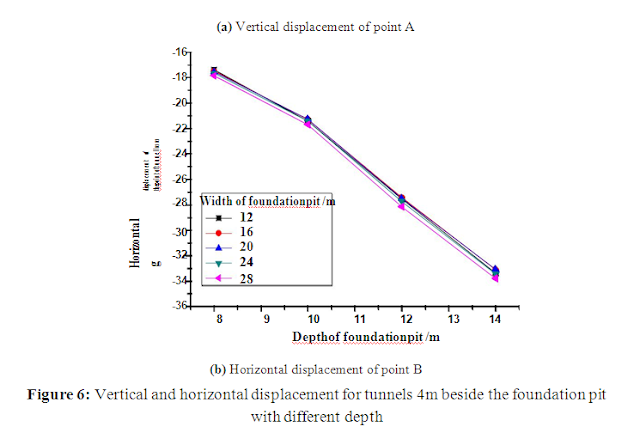Displacement Distribution of Tunnel Beside the Foundation Pit
Artikel terkait : Displacement Distribution of Tunnel Beside the Foundation Pit
Yangzong Zhou
School of Geosciences and Info-Physics, Central South University,
Changsha, 410083, China
Wenxiang Peng*
School of Geosciences and Info-Physics, Central South University,
Changsha, 410083, China
Corresponding author email: pengwenxiangcsu@126.com
Zhenbin Peng
School of Geosciences and Info-Physics, Central South University,
Changsha, 410083, China
School of Geosciences and Info-Physics, Central South University,
Changsha, 410083, China
ABSTRACT
Excavation of foundation pit result in the settlement and movement of nearby ground surface, which could influence the strain and deformation of adjacent tunnel and at last result in insecurity of engineering comes. The previous researches mainly studied the tunnel that is right below the inspiration pit notwithstanding the tunnel settled different positions. However, in the real practice, the tunnel may find at completely different places around foundation pit, thus, this paper set completely different locations of tunnel to reveal the variation of tunnel displacement with different parameters of foundation pit and relative locations of tunnel to foundation pit. As for tunnels beside the foundation pit, horizontal displacement of tunnel is larger than vertical displacement of that. Width of foundation pit has bigger impact on vertical displacement than horizontal one. Conversely, depth of foundation pit has greater impact on horizontal displacement. Furthermore, the effect of depth of foundation pit is bigger than that of dimension.
INTRODUCTION
For the past few years, with the development of urban underground engineering, increasing number of foundation pits square measure created in settled areas and shut to existing tunnels[1-5]. The issue concerning effects of excavation of foundation pit on the adjacent tunnel has been investigated by several students round the world [6,5]. For instance, Ji and Liu [7] studied the mechanism of tunnel deformation ensuing from excavation that is specifically higher than the tunnel, and summarized the computing method for displacement of tunnel created by adjacent excavation. Jiang and Liang [8] applied elastic theory to analyze the variation of stress qualitatively, created by excavation of foundation pit, in soil mass around the tunnel, and deduced the theoretical formula to calculate displacement of tunnel. However, all of these researches adopted certain assumptions that square measure based mostly on semi-empirical and semi-theoretical formulas. Moreover, former researches mainly targeted on qualitative analysis. With the dramatic progress of computer science, using numerical simulation for quantitative analysis in geotechnical engineering is kind of well-liked among several researchers [9-11]. Roboski [12] took advantage of finite element computing program CRISP to set a three-dimensional model for foundation pit, and then analyzed deformation of encompassing rock and soil through investigation the dimensions, the excavation way, and reinforcement of foundation pit. Blackburn [13] adopted PLAXIS to set a three-dimensional model of a definite foundation pit for numerical calculation and studied the mechanical result of each part in excavation. The previous researches mainly studied the tunnel that is right below the inspiration pit notwithstanding the tunnel settled different positions. However, in the real practice, the tunnel may find at completely different places around foundation pit, thus, this paper set completely different location of tunnel to reveal the variation of tunnel displacement with different parameters of foundation pit and relative locations of tunnel to foundation pit. Furthermore, this paper tries to form the formula to explain the vital areas wherever excavation of foundation pit could influence the deformation of adjacent tunnel.
Numerical modeling
Numerical calculation model is founded by FLAC3D in a plane strain mode, shown in Fig.1, which is mounted in all direction on rock bottom, and normal direction on every facet. Mohr-Coulomb criterion is used to explain the behavior of soil, parameters for the model is set as, 20kN/m3 unit weight, 20kPa cohesion, 25o friction angle, 14MPa elastic modulus, 0.3 Poisson’s quantitative relation. Diameter of the tunnel is 6m. As shown in Fig.2, the reinforcement of this tunnel is shortcrete-bolt supported where bolts square measure absolutely grouting bolts with 3m length, 100mm diameter, 250kN tensile strength, and 60kN pre-stress. Bolts are set on the higher circumference of circle with equal interval, with inclined angle of 9o. Parameters of shortcrete are listed as follows: C20 concrete, 25kN/m3 unit weight, 25.3GPa elastic modulus, 0.27 Poisson’s quantitative relation, 0.3m thickness. Aiming at calculating {different|totally completely different|completely different} parameters of foundation pit and deformation of tunnel at different relative position to the foundation pit, there are twenty five mixtures for calculation with dimension of foundation pit of 12m, 16m, 20m, 24m, and 28m and with depth of foundation pit of 6m, 8m, 10m, 12m, and 14m.
EXCAVATION ON DISPLACEMENT OF EXISTING
TUNNELS BESIDE THE FOUNDATION PIT
Owing to the symmetry of tunnel, tunnels located at the right aspect of foundation pit ar taken into thought. In order to research the impact of excavation on the present adjacent tunnel, two observation points ar set at the prime (point A) and therefore the left aspect of tunnel (point B) to record the displacement, as shown in Fig.2. The monitoring points facilitate to study displacement of tunnel because the modification of distance between the muse pit and therefore the center of tunnel similarly because the variation of dimension and depth of foundation pit, when the tunnel is set at 2 completely different positions (one is precisely below the muse pit, and the another one is at the correct side of foundation).
Fig.4 show displacement of tunnel with dimension of 12m at the right aspect of foundation pit (Fig.3). According to Fig.4(a), as the distance between the middle of tunnel and therefore the right side of foundation pit will increase, vertical displacement of point A decreases step by step when a fast increase at the distance of regarding 5m, and finally keeps constant. It is noted that vertical displacement of foundation pit with depth of 14m is much larger than foundation pits with other depth. According to Fig.4(b), as the distance between the middle of tunnel and therefore the right side of foundation pit will increase, horizontal displacement of point B grows up. When the distance is larger than 12m, the slope of horizontal displacement with varying depth of foundation pits is quite similar.
Fig.4 illustrates each vertical and horizontal displacement of tunnels 4m beside the foundation pit with completely different depth because the modification of its dimension. It can be seen from Fig.4(a) that with the increase of width of foundation pit, vertical displacement of point A for all tunnels 4m beside the foundation pit with distinctive depth will increase. As for foundation pits with depth of 8m, 10m, and 12m, vertical displacement of tunnel has a steady growth. Moreover, the amplitude of variation is almost a similar. However, as for the foundation pit with depth of 14m, vertical displacement is obviously larger than foundation pits with alternative dimension, which indicates the failure might occur in the foundation pit with depth of 14m. Based on Fig.4(b), whatever depth of foundation pit is, horizontal displacement of point B for tunnels 4m beside the foundation pit is almost unchanged with the variation of dimension of foundation pit. What’s more, the deeper depth is, the larger displacement is.
Fig.6 presents vertical and horizontal displacement for tunnels 4m beside the foundation pit with completely different dimension as depth changes. In Fig.6(a), as for foundation pits with varying dimension, as depth of excavation increases, a slight increase appears initial in vertical displacement of purpose A so a decreases replaced that. Until depth adds to 14m, vertical displacement increases quickly, which implies the muse pit with depth of 14m might fail. When depth of foundation pit with completely different dimension is 12m, vertical displacement of the top purpose A additionally reaches its least price. According to Fig.6(b), when dimension of foundation pit is the same, horizontal displacement of point B for tunnels 4m beside the foundation pit will increase as depth will increase. As for the foundation pit with varying dimension, curves describing horizontal displacement almost overlap. Summarizing Fig.5 and Fig.6, as for tunnels beside the foundation pit, width of foundation pit has bigger impact on vertical displacement of tunnel than its horizontal displacement. Contrary, depth of foundation pit has greater impact on horizontal displacement of tunnel than its vertical displacement. According to the amplitude of variation in displacement, horizontal displacement is larger than its vertical one. Depth of foundation pit has greater impact than dimension of that on displacement of tunnel
CONCLUSIONS
- Vertical displacement of purpose A and horizontal displacement of point B gift the trend of decrease as the distance between the tunnel’s center and therefore the foundation pit will increase. As the increase of width and depth of foundation pit, displacement presents the trend of growth. But as for foundation pits with completely different dimension and depth, the amplitude of variation of displacement, the slope and the convergence in tunnel are distinctive.
- As for tunnels beside the foundation pit, horizontal displacement of tunnel is larger than vertical displacement of that. Width of foundation pit has bigger impact on vertical displacement than horizontal one. Conversely, depth of foundation pit has greater impact on horizontal displacement. Furthermore, the effect of depth of foundation pit is bigger than that of dimension.
REFERENCES
- Li, J., Qiu, W. (2011) "Instability Risk Analysis and Management for Tunnel Foundation Pit Close to Building," China Railway Science, 32, 76-81.
- Liu, T., Liu, G.-b., Shi, S.-y. (2008) "Displacement of subway tunnels induced by above foundation pit reinforcement," Journal of Harbin Institute of Technology, 41, 141-144.
- Qin, Z. (2008) "Vibration influence on adjacent subway tunnel excited by blasting of brace system of foundation pit," Computer Aided Engineering, 17, 60-63.
- Zhang, Z.G., Zhang, X.D., Wang, W.D. (2007) "Numerical modeling analysis on deformation effect of metro tunnels due to adjacent excavation of foundation pit," Journal of Wuhan University of Technology (Information & Management Engineering), 29, 93-97.
- Zhu, D.P., Lin, Y.D., Yan, E. (2012) "Three-dimensional numerical analysis on excavation and support of deep pit near the subway tunnel by computer simulation technique," Journal of Theoretical and Applied Information Technology, 45, 621-626.
- Luo, Z.J., Zhang, Y.Y., Wu, Y.X. (2008) "Finite element numerical simulation of three-dimensional seepage control for deep foundation pit dewatering," Journal of Hydrodynamics, 20, 596-602.
- Ji, M.J., Liu, G.B. (2001) "Prediction method of displacement of subway tunnel due to excavation," Journal of Tongji University, 29, 531-535.
- Jiang, Z., Liang, J. (2013) "Analysis method of influence on longitudinal deformation of tunnel heaving due to excavation," Electronic Journal of Geotechnical Engineering, 18 W, 5473-5480.
- Poulsen, B.A., Adhikary, D.P. (2013) "A numerical study of the scale effect in coal strength," International Journal of Rock Mechanics and Mining Sciences, 63, 62-71.
- Sagong, M., Park, D., Yoo, J., Lee, J.S. (2011) "Experimental and numerical analyses of an opening in a jointed rock mass under biaxial compression," International Journal of Rock Mechanics and Mining Sciences, 48, 1055-1067.
- Zhou, X., Li, M., Zhan, Y. (2013) "Numerical Study for Buckling of Pile with Different Distributions of Lateral Subgrade Reaction," Electronic Journal of Geotechnical Engineering, 18, 81-89.
- Roboski, J.F. (2004) "Three-dimensional performance and analyses of deep excavations." Northwestern University.
- Blackburn, J. (2005) "Automated remote sensing and three-dimensional analysis of internally braced excavations." Evanston: Northwestern University.
- Huang Haibin, Cai Hao, and Zeng Jubo: “The Influence of Foundation Excavation On the Existing Metro Tunnel in Complicated Environment” Electronic Journal of Geotechnical Engineering, 2014 (19.N) pp 3377-3385. Available at ejge.com.
- Namazi, E., Mohamad, H., Jorat, M. E., Hajihassani, M. (2011) “Investigation on the effects of twin tunnel excavations beneath a road underpass”. Electronic Journal of Geotechnical Engineering, 16.
- Gao Shi-Ming, Chen Jian-Ping, Tang Xia Wang, and Shuang-Chao “Optimized Research on the Excavation Footage Cycle in Clay Strata Tunnel” Electronic Journal of Geotechnical Engineering, 2014 (19.Z1) pp 9799-9807.









0 Komentar:
Post a Comment